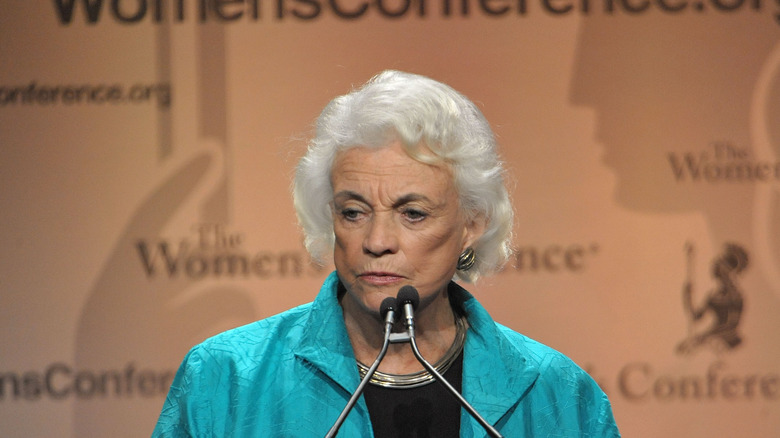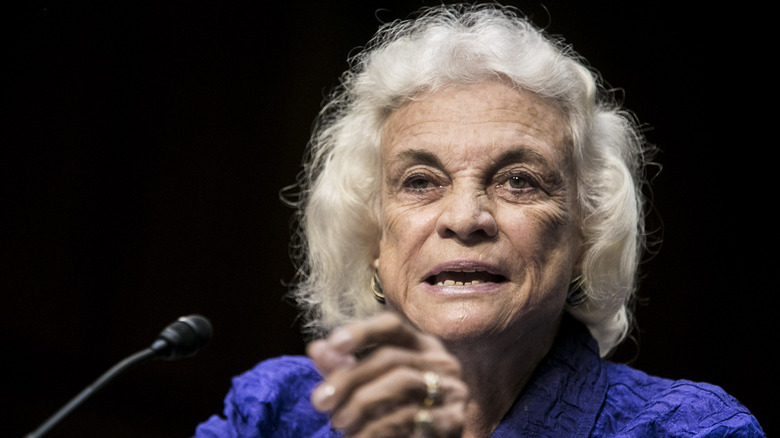Sandra Day O'Connor's Accomplishments Outside Of The Supreme Court
While Sandra Day O'Connor made history as the first woman to serve on the U.S. Supreme Court, it was far from her only accomplishment. Before her death on December 1, 2023, at 93, her life included many notable triumphs both before President Ronald Reagan nominated her to the highest court in the land in 1981 and after.
O'Connor earned a law degree from Stanford University. She later rose in politics to become an Arizona state senator before serving for 25 years on the Supreme Court. After she retired from the court in 2006, she continued her role in civic life. In 2009, she launched iCivics, a non-profit aimed at educating middle-grade and high-school students about how the government works. She told Parade in 2012 this was "the most important thing" she had ever done. Ever strong-willed and forward-thinking, in 2018 when she announced she had the beginnings of dementia and would be stepping away from public life, she urged her fellow Americans to continue her work in civics education (via the Sandra Day O'Connor Institute for American Democracy).
Before the Supreme Court
Sandra Day O'Connor was born on August 26, 1930, in El Paso, Texas, and spent much of her youth on her family's Lazy B cattle ranch in Arizona, per People. It was an unforgiving life full of hard work, but it taught her many valuable lessons she carried with her throughout her life. "It is possible to survive and even make a living in that formidable terrain," she recalled in her memoir "Lazy B: Growing up on a Cattle Ranch in the American Southwest." "The Day family did it for years: but it was never easy. It takes planning, patience, skill, and endurance."
O'Connor entered college at 16 and Stanford Law at 19, where she was the only woman in her class. Her career after law school included serving as an assistant attorney general for Arizona and later as a state senator, where she rose to the role of majority leader — the first female to do so not just in Arizona but across the entire United States. O'Connor said her time in the legislature helped her in her later role as a Supreme Court justice. "You certainly learn to work with people because you want to have as many on board for your position as you can," she told the Harvard Business Review. "And I think that's a desirable quality in a judge who is writing an opinion too."
Post-retirement
In 2006, Sandra Day O'Connor stepped down from her role on the Supreme Court to take care of her husband who'd developed Alzheimer's disease. But that didn't stop her from continuing to pursue other activities. Among her many roles, she was the chancellor of the College of William and Mary, sat on several charitable boards, and participated in various international law initiatives, according to the Supreme Court website.
O'Connor's alarm at the state of civics education in the U.S. led her to start iCivics, which released a series of free educational video games to boost students' knowledge of how the government works, per The New York Times. "My major activity since stepping down has been to try to educate young people in this country about how our government works and why they're a part of it," she told the Harvard Business Review. "Many states have stopped teaching civics."
In O'Connor's 2018 open letter concerning her dementia, she urged others to take up her cause of educating young people. "It is time for new leaders to make civic learning and civic engagement a reality for all," she wrote (via the Sandra Day O'Connor Institute for American Democracy). "It is my great hope that our nation will commit to educating our youth about civics, and to helping young people understand their crucial role as informed, active citizens in our nation."


